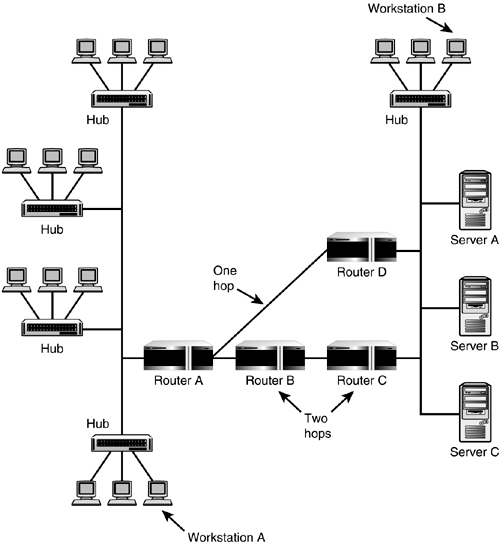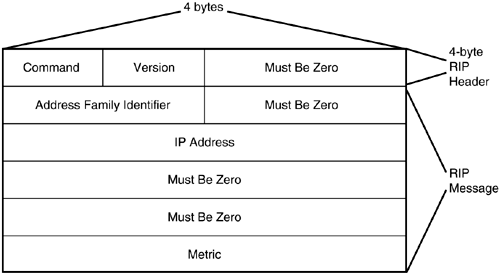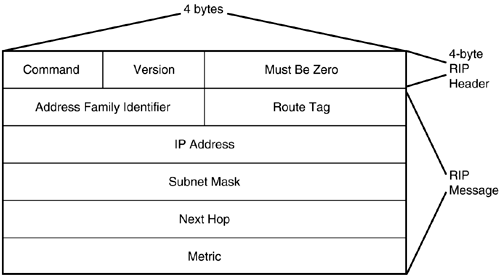Basic Types of Routing Protocols
| There are two general types of routing protocols: interior and exterior protocols. Interior protocols perform routing functions for autonomous networks. Exterior routing protocols handle the routing functions between these autonomous networks and glue the Internet together. These routing types are more commonly referred to as Interior Gateway Protocols (IGP) and Exterior Gateway Protocols (EGP). The network you manage for your business is an independent domain that functions internally as a unit. It is an autonomous system within which you can make decisions about which hosts use a particular address and how routing is done. When you connect your network to the Internet, the ISP or other provider manages routers that allow your autonomous system to exchange information with other routers connected to other autonomous systems throughout the Internet. For the most part, the network administrator is concerned with IGP protocols. Two are used most often: RIP and OSPF.
The Routing Information Protocol (RIP)RIP is an acronym that stands for Routing Information Protocol. It is the most common routing protocol for autonomous systems in use today, though that doesn't mean it's the best. There are newer IGP protocols that give additional functionality, but RIP, due to its low overhead, is still in wide-spread use. RIP is a distance-vector protocol, which means that it judges the best route to a destination based on a table of information that contains the distance (in hops) and vector (direction) to the destination. A hop is simply another router along the route that the packet will take. There is a limit to the number of hops a packet can take, and this is defined by which routing protocol is used. This value limits the number of routers a packet can pass through before it is dropped. Without this value, it would be possible for a packet to continue to travel through the Internet endlessly if the routers were not correctly configured. Figure 37.1 shows two company sites that are connected through two links that have routers between them. The user on Workstation A wants to connect to a resource in the remote network that resides on Server A. Figure 37.1. RIP decides the best route based on the number of hops between two nodes. When Router A sees the first packet from workstation A and realizes that it cannot be delivered on the local network, it consults its routing tables to first determine whether it can find a path that will get the data to its destination. If more than one path exists, as it does here, it then makes a decision on which path to take. A simplified version of the routing table information would look like this: Destination Next Hop Metric Server A Router D 1 Server A Router B 2 Router A has two paths it can use to get the packet delivered. The routing table it keeps in memory doesn't tell it the actual names of the servers, as is shown here. Instead, it uses network addresses. It also doesn't show every single router through which the packet will pass on its route to its destination. It shows only the next router to send the packet to and the total number of routers through which it will have to pass.
Earlier versions of RIP routing made simple decisions based solely on the metric called a hop count . In this case, RIP would decide to send the packet to Router D, because that route indicates that the packet has to pass through only one additional router to reach its destination network. If it were to route the packet through Router B, it would take two hops. The number of hops to a destination cannot be infinite. In RIP routing, the maximum number of hops that will be considered is 15. If a destination lies more than 15 hops away from the router, it is considered to be an unreachable destination and the router will not attempt to send a packet. When this happens, the router will send an ICMP Destination Unreachable message back to the source of the network packet. Because RIP is considered an IGP, most packets should never have to pass through more than 15 hops. For more information about ICMP (the Internet Control Message Protocol), see Chapter 25. Another situation that needs to be taken into account is that a network administrator can configure a router to use up more than a single hop or metric value. Because of this, it is possible that a network packet may be dropped before it passes through 15 actual routers.
As simple and straightforward as this might seem, it might not be the best route to take. One of the problems that RIP routing has is that it never takes into consideration the bandwidth of the route. The path from Router A to Router C might be made up of high-speed T1 links, and the line between Router A and Router D might be a slower connection. For small simple packets, such as an email delivery, this might not make a great deal of difference to the end user, because a few seconds or a minute or two won't make much difference for this type of application. For a large amount of traffic, though, this can make a significant difference. Routing a lot of traffic over slow links can significantly impact performance. Another problem with RIP is that it doesn't load balance. If a lot of users are trying to get to the remote system, it will not use both of the available routes and divide up the traffic. RIP continues to select what it considers the best route and just sends the packets on their way. You can also manipulate the metric value used in the routing table to make it appear that one route ”usually a slower link ”is farther away than a faster route simply by modifying the routing table to change the hop count of the slow route to a number larger than that of the faster route link. Thus, although a faster link might actually send packets through more routers than the slower link, you can "fool" RIP into using the faster link. Updating RoutersRIP routers periodically exchange data with each other (through the User Datagram Protocol, or UDP, using port 520) so that each router can maintain a table of routing information that is more or less up-to-date. In earlier versions of RIP, a router would broadcast its entire routing table. Newer versions allow a router to send only changes or to respond to routing requests from other routers (called triggered RIP updates). The format of the RIP message for version 1 appears in Figure 37.2. For version 1 of the protocol, the largest RIP message that can be sent in a UDP datagram is 504 bytes. When you combine this with the 8-byte UDP header, the maximum size of the datagram is 512 bytes. Figure 37.2. The format of the RIP message for version 1 of the protocol. In Figure 37.2, the portion following the first 4 bytes can be repeated as many as 25 times, depending on the number of routes that are being sent in a single message. The fields labeled Must Be Zero should contain all zero bits. The first field, Command, can have the following values, which indicate the purpose of the message:
The Version field denotes the version of the RIP protocol. For version 1 this field contains, of course, a value of 1. The Address Family Identifier field was defined in RFC 1058, but only one address type (the IP address) was defined, and the value for this field should be 2. The IP Address field is 4 bytes long and is used to store a network address or a host address. For most request messages, this value is set to the default route of 0.0.0.0. The final field is used to store the hop count, or metric, for the route. This field can contain a value ranging from 1 to 16. A value of 16 indicates that the destination is unreachable, or to put it in other words, "you can't get there from here." Because RIP version 1 was created before Classless Interdomain Routing (CIDR), and before the concept of subnetting was introduced, there is no subnet field in the message. Because of this, a RIP version 1 router must determine the network ID by examining the first 3 bits of the IP address, which determine to which class (A, B, or C) the network address belongs. From this it can apply the appropriate subnet mask for the class. If the address does not fall into one of these classes, the router will use the subnet mask associated with the interface on which it received the message and apply it to the address to determine whether it is a valid network address. If that subnet mask does not match up to create a network address, the mask of all 1s (255.255.255.255) is applied, and the address is assumed to be a host address instead of a network address. The message traffic generated by RIP routers can be significant in a large network. RIP routers update their routing tables every 30 seconds by requesting information from neighboring routers. They also announce their existence every 180 seconds ”hey, you have to allow for network latency and other network problems, so the 180 seconds value was chosen to give more than 30 seconds for another router to respond when changes are being sent or received. If a router fails to announce itself within this time, other routers will consider it to be down and will modify their routing tables . The router itself might have been taken offline by the network administrator, or it could have simply gone offline due to hardware failure. It's also quite possible that the network link between the router and the rest of the network has been broken. The thing to remember is that RIP routers dynamically update routing tables so that packets don't get sent out into the ether and just disappear! RIP Version 2Although other protocols, such as OSPF (described later in this chapter) were developed after the original version of RIP and contain more features, you might wonder why RIP version 2 was developed. The reasons are simple: RIP has a large installed base, and it's easy to implement and configure. And, for small to medium- sized networks, you don't necessarily need a more complex routing protocol when RIP will do the job just as well. Version 2 of the protocol uses a slightly different message format, as shown in Figure 37.3. Figure 37.3. Format of the RIP message for version 2 of the protocol. As you can see, the message format is the same size, but some of the fields that were previously reserved for all zeros have been put to use in version 2 of the protocol. Specifically, they contain Route Tag, Subnet Mask, and Next Hop fields.
The Route Tag field is an administrative field used to mark certain routes. This field was introduced in RFC 1723 so that routers that support multiple routing protocols could distinguish between RIP-based routes and routes imported from other routing protocols. The Subnet Mask field is used to implicitly store a subnet mask associated with the IP address field so that the router does not have to try to determine the network or host address. Applying the mask can yield this result. The Next Hop field is used to indicate the IP address to send packets for the destination advertised by this route message. If this field is not set to 0.0.0.0, the address in this Next Hop field must be reachable on the logical subnet from which the routing advertisement originates. Disadvantages of RIPRIP is a good routing protocol to use in small networks, but it doesn't scale very well to very large networks. It became quite popular early on because it was distributed as part of the Berkeley version of Unix, in the form of the routed daemon. The following are the major disadvantages of RIP:
OSPF (Open Shortest Path First)RIP is a vector-distance protocol, whereas OSPF uses a link-state algorithm. OSPF routers maintain a routing table in memory just as RIP routers do, but instead of sending out the entire routing table in a broadcast every 30 seconds, OSPF routers exchange link-state information every 30 minutes. In between that interval, very short Link State Advertisements (LSAs) are used to send changes to other routers. The Open Shortest Path First (OSPF) routing protocol (version 2) is defined in RFC 2328, "OSPF Version 2." OSPF was developed by the Internet Engineering Task Force and was meant to solve most of the problems associated with RIP. Instead of using a simple hop count metric, OSPF also takes into consideration other cost metrics, such as the speed of a route, the traffic on the route, and the reliability of the route. Also, OSPF does not suffer from the 15-hop limitation that RIP employs. You can place as many routers between end nodes as required by your network topology. Another difference between RIP and OSPF is that OSPF provided for the use of subnet masks at a time when version 1 of RIP did not. Although OSPF functions more efficiently than RIP, in a large network the exchange of information between many routers still can consume a lot of bandwidth. The time spent recalculating routes can add to network delay. Because of this, OSPF incorporates a concept called an area , which is used to divide up the network. Routers within a specific area (usually a geographical area, such as a building or campus environment) exchange LSAs about routing information within their area. The Link State Database (LSDB) and AreasEach router maintains a Link State Database (LSDB), in which it stores the information it receives through LSAs from neighboring routers. Thus, over time, each OSPF router essentially has an LSDB that is identical to other routers with which it communicates. Each router is assigned a router ID, which is simply a 32-bit dotted decimal number that is unique within the autonomous network. This number is used to identify LSAs in the LSDB. This is not to be confused with the actual IP addresses of the router's interfaces, but is merely a number used to identify the router to other routers. However, most implementations of OSPF will use either the largest or the smallest IP address of a router's interfaces for this value. Because IP addresses are unique within the autonomous network, Router IDs also will be unique. A router that is used to connect these areas with a backbone of other routers is called a border router . A hierarchy of routing information is built using this method so that every router does not have to maintain a huge database showing the route to every possible destination. Instead, a border router will advertise a range of addresses that exist within its area instead of each address. Other border routers store this information and therefore have to process only a portion of an address instead of the entire address when making a routing decision. Border routers store this higher level of routing information and the information for routes in their area. In Figure 37.4, you can see a network that has four major areas, each of which has routers that maintain a database of information about its specific area. These routers exchange information with each other that keeps them updated. Each area has a border router that is part of the area and also part of the backbone area. These border routers exchange summary information about their respective areas with other border routers that are part of the backbone area. Figure 37.4. OSPF routers are responsible for their areas. OSPF has the drawback of administrative overhead. Also, low-end routers might not be capable of coping with the amount of information a border router needs to manage. OSPF Route CalculationsI'll leave the exact explanation of how OSPF calculates the best route to the mathematicians. However, for those who are interested, the algorithm used is called the Dijkstra algorithm, and it is used to create a shortest path tree (SPF tree) for each router. This tree contains information that is valid only from a particular router's point of view. That is, each router builds its own tree, with itself as the root of the tree, while the branches of the tree are other routers that participate in the network. Thus, each OSPF router has a different tree than other routers in the network. From this tree, the router can build a routing table that is used for the actual lookup that is performed when deciding which interface a packet should be sent out on. |
EAN: 2147483647
Pages: 434



